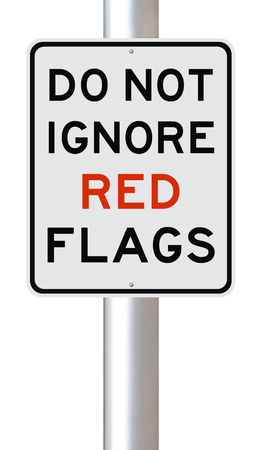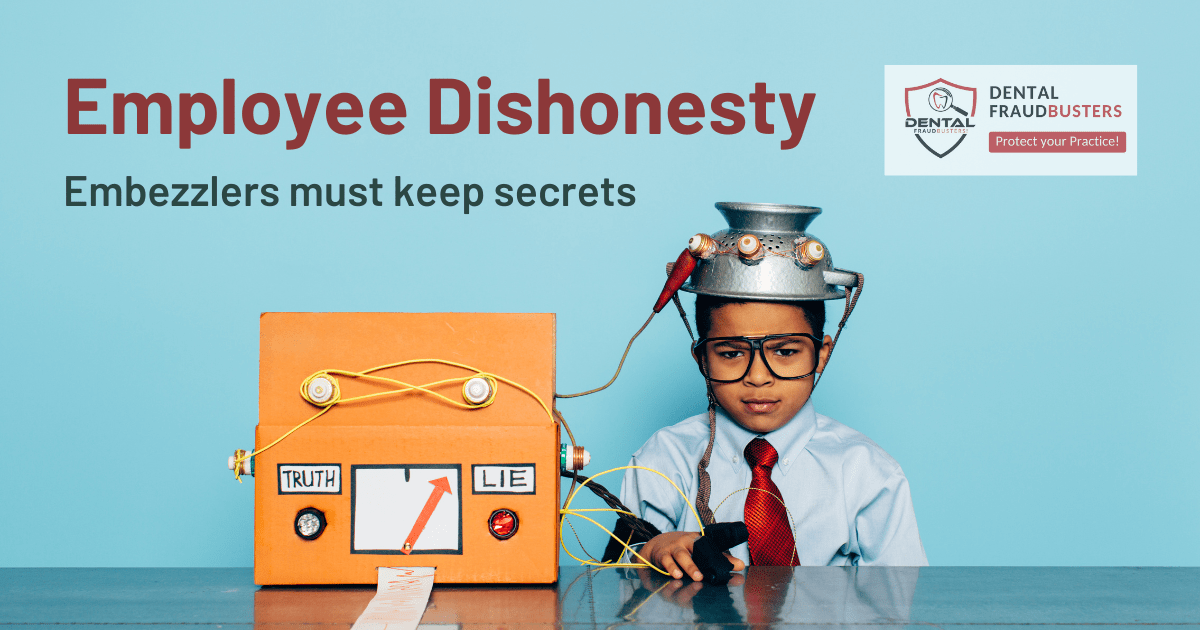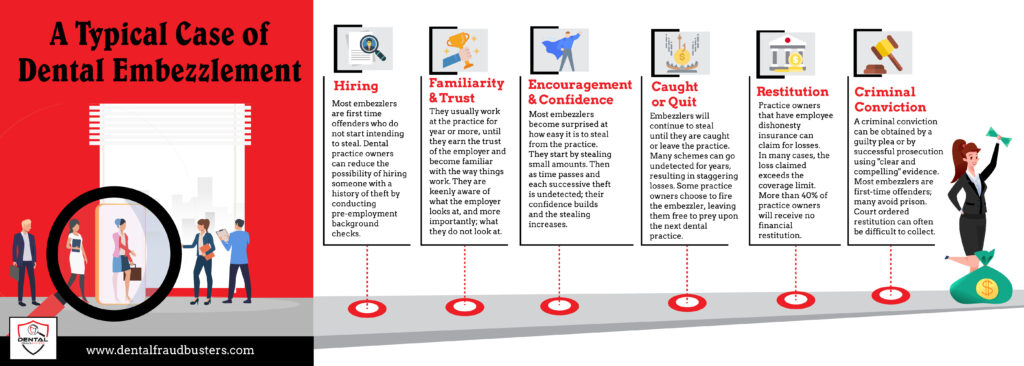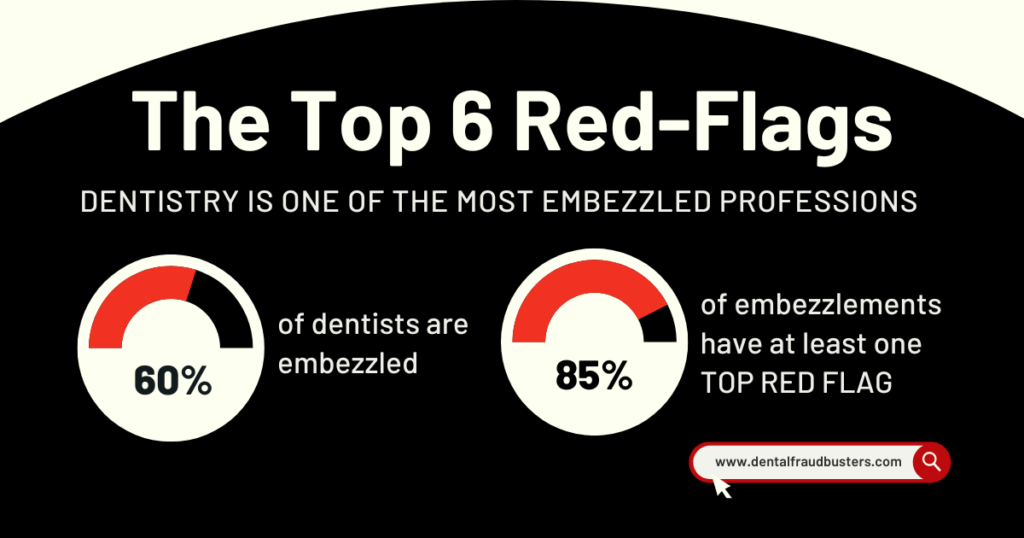DENTAL EMBEZZLERS MUST KEEP SECRETS
Dental office theft is common.
Widely published statistics say that 6 out of 10 dentists will be a victim of employee dishonesty, and virtually every dentist knows of another dentist or a classmate who was embezzled.
It doesn’t matter if you practice alone, in a group; or whether your practice is urban, suburban or rural; odds are that at some point an employee will decide to steal.
Dishonest employees will find ways to understate your fees, conceal payments, create phantom transactions, pocket cash, forge signatures, abuse credit cards, and the list goes on.
The sad reality is, when an employee is intent on stealing, they generally can find a way to do it.
Usually the stealing begins “slow and low”.

The thief will steal a small amount at first, then they will wait a week or two before they do it again.
After they realize that the stealing has gone unnoticed, they begin to repeat the stealing process with ever increasing confidence and frequency. They steal more dollars, more often.
Over time, dishonest employees will adapt and refine their schemes so that stealing just becomes “another part of their job.”
Theft schemes can go on for years with huge dollar losses.
The perpetrators invariably adulterate the practice’s accounting and patient records to conceal their crime.
When a dishonest employee believes they will be caught, they may try to erase information, shred documents and remove patient charts and other information from your practice in order to conceal evidence.
A Typical Case of Dental Embezzlement
See a Typo or an Error? Report it.
One of the clues to early detection is observing employee behaviors.
Psychologist Kurt Lewin proposed a heuristic formula as an explanation of what determines human behavior.
Lewin’s equation:
The formula states that behavior is a function of the person and his or her environment.

B = f (P, E)
Where B is behavior, P is person, and E is the environment.
Embezzlers change their work environment to conceal their stealing, and accordingly change their behavior.
Most dental embezzlers are first-time criminals whose fear of being caught causes them to behave in odd or erratic ways.
Embezzlers Must keep secrets
Embezzlers must conceal their thefts, so as not to arouse your suspicion.
They are always on constant alert and leery of being caught. Over time, this causes them to exhibit behaviors that are highly correlated with their dishonest activity.
Observing behaviors consistent with theft is often the first sign that something may be wrong.
Here are a few red-flag behaviors that that dentists need be aware of.

- Be aware of an employee who has visible signs of money problems. These employees may make comments or complain about not having enough money. The cause of their money problems may be visible to the dentist; things like gambling, alcohol or drug addiction, marital problems, calls from collection agencies at work, large medical bills or a spouse who lost their job.
- Be aware of an employee who spends time alone in the office after hours or always comes in early.
- Be aware that dishonest employees will often refuse to take vacation or come in to work when they are sick and should have stayed at home.
- Employees who steal often become “jumpy” when someone tries to help them with their duties. They will resist the involvement of others in their work. “Don’t touch that until I get back.”
- Be aware of an employee who is resistant to change. Embezzlers do not want changes in things like practice management software, bookkeeping, accounting or consulting services.
- Embezzlers are often slow to respond requests for information. The report you asked for today may not show up on your desk until tomorrow. They often become annoyed when asked reasonable questions about financial transactions or dental insurance claims.
- Some embezzlers will attempt to cover up their actions by wanting you to believe that they are always one step ahead and keeping you informed. This perception of organization is essential to maintain the bond of trust that is required for them to steal.
If you observe one or more of Embezzlement Red Flags, it warrants further examination.
If you are unable to find a reasonable explanation for the Red Flag, then you should consider looking deeper. If you need help where to look, contact me for some free advice.
I recommend that you look for Embezzlement Red Flags in your practice at regular intervals.
-> CLICK HERE TO LEARN ABOUT THE TOP 6 RED FLAGS
FraudBuster Tip: Check your Employee Dishonesty Coverage
Employee dishonesty insurance is a type of coverage that can help you recover revenue should your employee harm your practice by misusing funds or stealing.
Check your CGL (business insurance) policy for “financial crime” or “employee dishonesty” insurance.
Many policies have between $5,000 and $25,000 in coverage. Consider increasing your coverage to $50K or more.
If you are the victim of embezzlement, you can then file a claim against your employee dishonesty insurance to help offset your losses and/or help pay for the professional expenses you incur to produce your claim.
FraudBuster Tip: Check your practice for Embezzlement Red Flags
“Take my Dental Embezzlement Red Flag Self-Assessment by clicking the image below.”
– Bill Hiltz
How to Get in Touch

Hiltz & Associates
and the creator of
Dental FraudBusters.
Questions? Here’s How to Get in Touch
Report an Error or Typo.
If you see an error or spot a typo, please let me know.
Send your comments directly to Bill Hiltz using the form below.



